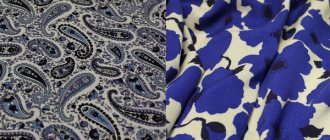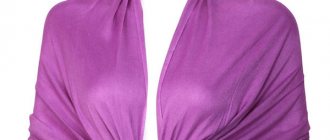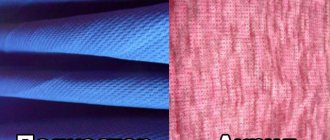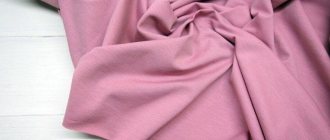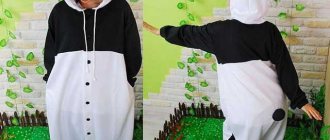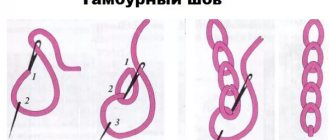What is acrylic fabric
In the collection of modern synthetic fabrics, acrylic fabrics take pride of place. The name “acrylic” is translated as synthetic acrylic resin.
Despite its artificial origin, fabric made from acrylic fibers is soft and light. Very reminiscent of natural wool. Apparently, this is why it is often called “artificial wool.” This is due not only to external similarity. According to some characteristics, acrylic fiber is superior to wool yarn. It is more durable, smoother, and the fabric made from it has a clearer pattern.
History of origin
In the middle of the last century, the DuPont company (USA) was actively working to create a new material that could compete in quality and properties with nylon, which was popular at that time. The result of these studies was the appearance of synthetic fiber “Orlon”, isolated from polymers. The material turned out to be incredibly practical and in many respects was superior to many artificial and natural analogues at that time.
However, the new fabric had a significant drawback - the fibers were practically resistant to dyeing. Only in 1952, four years later, DuPont chemists were able to solve this problem. Essentially, they created a new version of a previously invented synthetic fabric that now met all the requirements. And most importantly, it was beautifully colored.
This date is considered the birth of acrylic fabric, which in subsequent years quickly spread in the textile world and surpassed nylon in many respects. In the USSR, the universal synthetic acrylic fabric was known as nitron fiber or nitron. We can say that from this moment began the era of artificial wool and trendy material, which has dominated the production of quality clothing throughout the world for the second century.
What is acrylic made from?
The raw material for the production of synthetic fibers is natural gas, from which chemical compounds are obtained. With their help, acrylic fibers are synthesized.
The dominant material in this process is acrylonitrile, from which polyacrylonitrile is obtained by polymerization in the presence of catalysts. The share of acrylonitrile in the composition of raw materials for the production of synthetic fibers, according to international production standards, must be at least 85%.
The main component of acrylic fiber is a toxic substance in itself. However, the resulting acrylic synthetic fiber is safe for use. Because acrylonitrile, when combined with other elements during the synthesis process, quickly decomposes.
As a result of a series of chemical reactions, acrylic fiber is formed into a continuous thread from a solution of polyacrylonitrile resin. Due to the special structure of acrylic threads, the finished material is high-quality, smooth, with a clear weaving pattern; acrylic items, clothes, and textiles are made from it.
When producing various products, manufacturers use either a wet or dry method of spinning fibers.
Having received a synthetic solution in the form of a colorless liquid after synthesizing the raw materials, technologists send it into a container with air or water, rotating and squeezing it through special equipment. There, after some processing, the fiber hardens. Then it is washed, dried, and cut to the required length.
The dried threads are wound into balls, from which acrylic fabric is woven using various techniques: plain, knitted, jacquard, matting.
To give the material an original “woolen” structure, after processing the synthetic fiber is cut into staples - narrow strips of equal size. They are woven into threads that imitate natural wool. They are used to knit interior items and warm clothes for adults and children.
A special feature of acrylic fabric is its characteristic dyeing method. Paint is added to the raw material during its production process, rather than impregnating the finished canvas with coloring pigments, as is usually the case. This technology gives excellent results. Paints that do not fade for a long time penetrate deep into the structure of the canvas, saturating it with bright color.
Manufacturers produce acrylic fabrics in different colors. In terms of design, the canvas can be printed with geometric, floral prints, patterns or plain.
Most acrylic fiber is produced in China, the USA, Russia, and Spain.
Products with the addition of acrylic: care rules
To wash acrylic items, you should choose water at room temperature in a machine or by hand.
They cannot be twisted .
It is advisable to dry in a horizontal position.
Iron with a barely warm iron and preferably through damp gauze or a special mesh.
Acrylic composition
Acrylic fiber is based on a polymer – acrylonitrile. And although 100% synthetic fiber may well exist as an independent unit and be used, it is still almost never found in its pure form.
It usually contains artificial or natural fibers in one quantity or another. Manufacturers use viscose, cotton, wool, and polyester as such additives, which significantly improve the original properties of synthetic fabric.
- Viscose increases the elasticity of the material, giving it softness and silkiness.
- Polyester makes the fabric more durable and moisture resistant.
- Wool improves the appearance of the material and increases its performance properties.
- Cotton gives synthetic fabric the hygienic properties of natural material.
Is acrylic a natural or synthetic material?
Having studied the composition of acrylic, you can clearly answer this question, which is often asked by buyers when encountering this fabric for the first time. According to the manufacturing method and the raw materials used, it is a synthetic material. And it was obtained artificially. However, this is not a reason to refuse acrylic fabric because it is made from petroleum products.
At all stages of production, synthetic fabric is tested for environmental safety and quality. The best guarantee that the material will not harm is the recommendation to use many types of it in the production of children's clothing. And the more natural fibers acrylic fabric contains, the safer the clothing.
Properties of acrylic
The material is elastic, durable, wear-resistant.
Acrylic fabric is resistant to acids and alkalis, does not deform when washed, does not shrink, or fade. But with constant exposure to ultraviolet radiation, the structure can change: become rigid and dry out.
When burned, the fabric melts, producing black smoke with a sour odor characteristic of synthetic fabrics, and bakes into a solid lump. Based on these signs, you can understand that this is synthetic and not natural fiber.
The fabric is comfortable to wear and rarely causes allergies.
Advantages and disadvantages
The list of disadvantages and advantages is compiled based on customer reviews and will complement the general understanding of this material.
Here's what most of them note as advantages:
- brightness of colors and shades, variety of colors and patterns;
- The material is soft in texture and pleasant to the touch;
- environmental Safety;
- hypoallergenic;
- good heat-saving properties and moisture resistance;
- easy care: the fabric wrinkles little and retains its shape well, is easy to wash, dries quickly, and does not shrink;
- Due to the elasticity, clothing made from acrylic is comfortable: nothing hinders movement;
- synthetic fabric is not damaged by moths;
- does not fade in the sun and does not fade when washed with powder;
- I'm attracted by the affordable price: things and acrylic yarn are always on sale.
It is worth mentioning the disadvantages:
- clothes made of acrylic become electrified and attract dust - using antistatic agents you can cope with this problem;
- in the heat, you can quickly sweat in such clothes, the fabric does not “breathe” well - the problem is solved if you use a material that, in addition to acrylic, contains at least 30% natural fibers;
- when worn for a long time, the fabric rolls up and pellets may appear on its surface - the clothes can be cleaned;
- oil and grease stains that get on clothes are absorbed instantly and are difficult to wash off;
- when dried, things become rigid and become even more electrified;
- not all types of acrylic fabric are suitable for children's clothing;
- Things can stretch and become deformed if not properly cared for.
Expert opinion
Natalya Kadatskikh
Designer, fabric expert with 20 years of experience
Acrylic clothing retains heat well and dries quickly after washing. These fabric properties are often used for sewing winter models. But acrylic fabric is by no means a rare guest in summer clothes. It is often used in the production of lightweight knitwear.
Detergents
Acrylic products must be cared for using special products. For nitron it is recommended to use a special gel. It dissolves easily in cool water and works well on stains, penetrating deeply into synthetic fibers.
The great advantage of the gel is its ability to be completely washed out of the fabric.
The use of aggressive substances (for example, chlorine) for acrylic fabrics is strictly prohibited.
Bleaching acrylic items
Many white things lose their whiteness over time. If purchased products do not give the desired result, then you can try to “reanimate” the product using home methods.
Bleaching gray acrylic fabrics. Grayness on white nitron appears due to improper and frequent washing and hard water.
To wash away the particles that color the white fibers an unsightly gray color, use baking soda. To do this, dissolve 5 tablespoons of soda in 5 liters of warm water and add one spoon of ammonia. Soak the product in this solution for 4 hours. Baking soda softens plaque, but does not wash it away. After soaking, wash the item according to all the rules in a machine or by hand.
ARTICLE FOR YOU
How to wash interlock items: in the washing machine and by hand
You can try to bleach a grayed item using salt. Dissolve 300 g of fine salt in 5 liters of warm water. Soaking lasts about 3 hours, after which the item is washed in the usual way.
Whitening with salt
Whitening yellowed acrylic items. Yellowness indicates that the nitron fibers have reacted with some compounds. The cause may be sun rays, chlorine, rust, improper detergents (not intended for white products), dirty water when rinsing, the use of perfumes that always contain oils, and organic contamination from the body.
To remove yellowness, use the following means:
- laundry soap (rub the item with it and leave it in the soap solution for 2-3 hours);
- ammonia;
- hydrogen peroxide (100 ml per 5 liters of water).
Ammonia and hydrogen peroxide are added in smaller quantities to keep clothes white.
Drying
Acrylic fiber products should only be dried horizontally. For this purpose, a special grid is used. If there is none, take any horizontal surface, covering it with a towel or other fabric that absorbs moisture well.
You cannot dry synthetics on a rope or radiator. Vertical drying on clothespins or hangers causes the product to stretch. Drying on a radiator, in addition to deformation, contributes to the appearance of stains and color fading.
The sun's rays should not fall on the fabric for a long time. It may turn yellow or lose color.
Ironing
Acrylic clothes are not ironed, as they do not wrinkle. If wrinkles have formed due to long-term storage, ironing should be done on delicate fabrics without steam. Use damp gauze or cotton to prevent damage to clothing.
Do not use steam generators to iron acrylic items. The steam has a high temperature and will cause fiber deformation. By following these care rules, your items will remain warm for a long time and delight you with their appearance and softness.
Types of acrylic fabrics
By combining pure acrylic with natural and artificial fibers, new materials with improved properties are obtained. For example, vinyl or polyurethane coating increases the water-repellent properties of acrylic fabric and increases its abrasion resistance.
Polyacrylic
Consists of 95% acrylic fibers and 5% wool, cotton, angora threads. Clothes made from polyacrylic are very warm, comfortable, and comfortable. In terms of quality, it can easily replace things made from angora or natural wool.
In fact, acrylic and polyacrylic are the same material. The prefix “poly” indicates that polymer fibers were used in the production of this fabric.
Modacrylic (modified acrylic)
Polyacrylic and vinyl fibers are used in its production. Curtains and drapes for window decoration are most often made from this fabric.
Microacrylic
Knitted items are knitted from acrylic yarn using a knitting machine and by hand.
Acrylic yarn
Acrylic, acrylic, acrilik, acrylique, PAN (bulk), cashmilon, nitron, orlon, acrylan, dralon, kurtel, prelan - all these are trademarks and names of durable synthetic fiber made of polyacrylonitrile, from which yarn is made that resembles wool in properties and structure .
Contrary to popular belief that acrylic fabric equals wool, this is not true. There are not only similarities between them based on the same characteristics, appearance, scope of application, but also differences.
Acrylic is cheaper to produce. Superior to natural material in thermal insulation properties, strength, shine, brightness of colors, elasticity, lightness, resistance to humidity, and high temperatures. Clothes made from acrylic do not ripple, do not shrink after washing, and dry quickly.
Although there are also disadvantages - the fabric wears out quickly (those who knit acrylic socks know this), pellets form on it, which are difficult to remove, and become electrified. Items made from artificial wool are not as warm as those made from natural wool.
Both materials: synthetic and its natural counterpart have their pros and cons. To minimize the disadvantages of both and improve their quality, manufacturers often produce blended fibers in different proportions. For example, if 100% wool is diluted with acrylic, the yarn does not shrink after washing and its wear resistance increases.
And for those who suffer from an allergic reaction to wool, acrylic knitwear is an excellent replacement.
Washing in a washing machine
Items that do not have any special instructions on their labels are suitable for machine washing. Colored underwear is selected by color, white separately.
ARTICLE FOR YOU
How to properly wash voile fabric
Preparing things:
- fasten all fasteners;
- check pockets and folds for debris and other items;
- turn inside out;
- remove all difficult stains in advance.
Before loading into the machine, acrylic items are soaked for 10 minutes in soapy water. The drum should not be heavily loaded. Things take up less than half the space. Synthetic fabrics need a lot of space to perform well. If possible, turn off the spin and dry functions.
To prevent things from becoming deformed or stretched after washing, use the mode for thin fabrics (synthetics, silk or wool), the temperature is not higher than 30 degrees. In this case, the washing machine will use a gentle spin and low speed without damaging the fabric structure. To prevent stretching, special mesh bags are used. They do not allow things to stretch while the centrifuge is running.
To prevent acrylic fiber from losing its shape and softness, use special products for synthetics, as well as conditioners and tap water softeners. Hard water makes acrylic rough and increases the chance of pilling.
Fabric softener
How to wash without shrinking fabric
To prevent clothes made from acrylic fiber from shrinking, you need to maintain temperature conditions. If the water temperature is above 40 degrees, then there is a high probability of deformation of the fabric.
If the item could not be saved and it has shrunk, then you can try to return it to its original form. Examine it. In the case when the change in size does not occur evenly and the clothing looks like a disproportionate flap, nothing can be done. It can be thrown away or used for other purposes.
When the size has become smaller, but the clothing has retained its appearance, you can return to the original parameters. To do this, soak the clothes in cool water with synthetic conditioner added for 10-15 minutes.
Wring out the water by wrapping the clothes in a towel. Do not twist, just squeeze and let the water drain. Place on a horizontal surface and stretch, securing in the desired position. In this form, the clothes should dry. A shrunken hat can be pulled over a jar or other suitable object.
ARTICLE FOR YOU
How to properly wash knitwear
If the conditioner procedure does not help, there is a more extreme option. Add turpentine and ammonia in small quantities to the water for soaking (no more than a tablespoon of turpentine, and no more than 3 alcohol for soaking one item). Attention! This method is not suitable for natural wool!
If the sweater or T-shirt has decreased in width, put the wet item on yourself and let it dry.
The sweater shrank after washing
How to wash things to sit down
If clothes have stretched as a result of careless wear or strong spinning in a washing machine, then their appearance can be restored in the following way.
When this happened as a result of an incorrect spin mode, the stretching is usually uniform and along the entire length of the product. You can return it to its original size by washing the item in compliance with all the rules and using conditioner.
Stretched sleeves on a sweater or turtleneck appear due to constant pulling and tugging. To correct this defect, immerse only the problematic parts in water at a temperature of 50 degrees. Dry on a horizontal surface. It is not recommended to use too high a temperature as this will destroy the nitrone.
What is made from acrylic and where else is it used?
Acrylic, thanks to the structure of the synthetic material and the use of various techniques of knitting and weaving threads, produces a variety of products. And not only in the textile industry, but also in related industries.
Synthetic wool makes excellent warm clothing, jackets, sweaters for adults and children, and accessories for cold weather (scarves, gloves, hats, socks).
Acrylic with the addition of polyester is used to make soft toys, home textiles, decorative items, curtains, furniture upholstery, sports and travel clothing.
Knitters are well acquainted with knitting threads that contain 100% acrylic or with any additives.
The advertising sector has not neglected the wear-resistant and durable material from which banners, streamers, and signs are made.
Manufacturers produce tents, tents, covers and other outdoor coverings for various purposes from dense fabric resembling awnings.
Areas of use
The structure of the artificial material allows it to be used in a huge range of products. Synthetic fibers can be supplied by manufacturers in dyed, undyed, or pigmented form. In the latter version, the fibers have an amazing light absorption coefficient, which is ideally combined with the production of curtains from acrylic fabric.
The material is widely used not only in the creation of outerwear, sweaters, socks, jackets and other everyday items, but also in the production of home textiles, various decorative elements and other unpredictable household items. Acrylic fiber for linen is far from the most popular way to use acrylic in the modern world. The material is extremely widely used in the production of soft toys and forms the basis of the entire industry of upholstery materials for furniture. The highest degree of wear resistance and durability provide excellent reasons for this, and most manufacturers of high-quality sofas use acrylic fibers as the main material for upholstery fabrics.
A separate segment of the mass use of synthetic material is the advertising sector. Streamers, banners, citylights and other outdoor POS materials are made on the basis of acrylic fibers. The main difference between this method of application and artificial fabric is the density of the fibers. In the case of profile canvases adapted for printing, acrylic is bonded extremely tightly and resembles awning fabric, which is much stronger and more durable than paper. This allows numerous manufacturers to create marquees, tents and other outdoor coverings for various purposes.
In the modern world, the use of acrylic has much greater variability than it might seem at first glance. The next time you hold in your hands any product made on the basis of artificial fabric, remember that you are holding one of the most used and widespread materials on the planet, which is equally successfully used both in printing and your favorite and warm sweater
Rules of care
Each material, depending on the components included in its composition, has features that must be taken into account when caring for the fabric. The manufacturer reports this on clothing tags. But there are also general recommendations that should be followed when caring for products made from it.
How to wash
You can wash it in any way, but it is better to wash it by hand. Not too often and in water up to 30 degrees. At higher temperatures, the item may stretch, deform, and lose softness.
If washing by machine, you need to put two or three items in the drum, placing them in a bag. This will save your clothes from creasing.
To ensure that the fibers retain their original softness, it is recommended to use conditioner when rinsing.
How to do push-ups
It is better to do this manually so as not to disturb the structure of the fabric when drying in a centrifuge, without twisting or squeezing too much. If drying in a machine, do it only at minimum speed.
How to dry
It is advisable to dry acrylic clothes on a horizontal surface, after straightening out folds and creases. Keep out of the sun and away from heating appliances. It is important not to overdry.
How to iron
It is better to avoid this procedure. But if this is not possible, iron with a lukewarm iron through cotton cloth or gauze. If creases form, do not use steaming. This may stretch the edges of the garment unevenly.
Some types of acrylic clothing can be dry cleaned. Permissive information in the form of an icon is indicated on the clothing label.
If the item is slightly dirty, you can not wash it, but try to remove the stains by applying a soap solution to them for 15-20 minutes. Then remove any remaining detergent with a sponge.
Important: before you start washing acrylic clothing, you must read the information on the product label.
Handwash
If the acrylic product has a large knit, it is still better to wash it by hand, as the knitwear may become deformed in the machine. The most convenient way to do this is in the bath.
- Warm water is drawn into the bottom of the bathtub and wool washing powder is dissolved in it. You can also use liquid detergents to wash wool.
- The item is placed in the solution and immediately begins to be carefully washed. When washing, special attention should be paid to the neckline and cuffs, as they get dirty the most.
- After washing, the item is left in the solution for exactly 15 minutes. After this, carefully wash it again. Rinse the acrylic in cool water, wring it out lightly and lay it out on a flat surface on a terry towel to dry.


